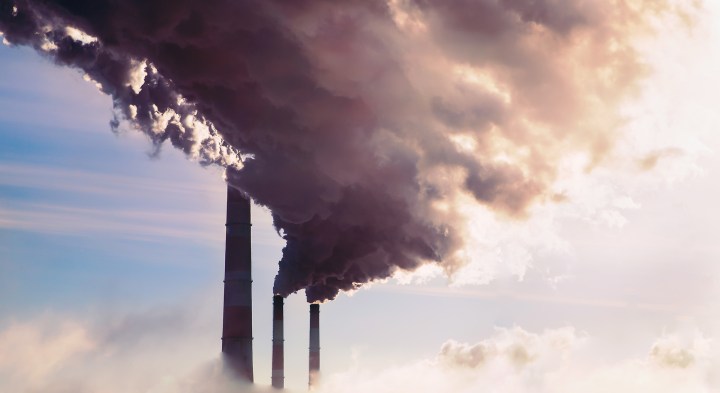GLOBAL ENVIRONMENTAL CRISIS
Greenhouse gas emissions are tipping the scales and, yes, every fraction of a degree matters

Just weeks ahead of United Nations climate change negotiations to be held in Egypt, various agencies of the UN have underscored the urgent, substantial work that needs to be done globally. Their reports show that greenhouse gas emissions have reached record highs and worryingly, efforts to rein them in have so far been ‘insufficient'.
A new synthesis report from United Nations Framework Convention on Climate Change (UNFCCC) on the state of nationally determined contributions (NDCs) under the Paris Agreement published on Wednesday, 26 October, shows that while countries are “bending the curve of global greenhouse gas (GHG) emissions downward”, the efforts at present are insufficient to limit global temperature rise to 1.5°C by the end of the century.
Instead, at our current trajectory, the planet is on track to be 2.5°C warmer than pre-industrial revolution, due to human activities.
Professor Francois Engelbrecht, a climatologist at the Wits Global Change Institute and Dr Pedro Monteiro, then Chief Oceanographer at the Council for Scientific and Industrial Research (CSIR), in an Our Burning Planet Op-ed previously explained that 1.5°C and 2°C are the thresholds that define “dangerous climate change”.
“These thresholds are directly informed by the physical science base of climate change; above these levels, aspects of climate change become increasingly dangerous in terms of impacts, while aspects such as the melting of large ice sheets may become irreversible with costly risk consequences for coastal infrastructure,” they wrote, adding that “further increases in global warming will result in further increases in the frequency and intensity of extreme events across the globe”.
The 26 October UN report “synthesises information from the 166 latest available nationally determined contributions communicated by 193 Parties to the Paris Agreement and recorded in the registry of nationally determined contributions as at 23 September 2022”.
The UNFCCC describes NDCs as being “at the heart of the Paris Agreement and the achievement of its long-term goals” and that they “embody efforts by each country to reduce national emissions and adapt to the impacts of climate change”.
Ahead of Cop26 in Glasgow, Scotland last year, South Africa revised its carbon emission targets range to between 350 to 420 metric tonnes of carbon dioxide equivalent (Mt CO2-eq). The country’s lower target range of 350Mt CO2-eq is compatible with the Paris Agreement’s 1.5°C target.
South Africa takes bolder steps to reduce emissions — but are they enough?
The synthesis report explains that “current commitments will increase emissions by 10.6% by 2030, compared to 2010 levels. This is an improvement over last year’s assessment, which found countries were on a path to increase emissions by 13.7% by 2030, compared to 2010 levels.”
Visit Daily Maverick’s home page for more news, analysis and investigations
A world off-track
In a statement, Simon Stiell, Executive Secretary of UN Climate Change, said that “the downward trend in emissions expected by 2030 shows that nations have made some progress this year… but the science is clear and so are our climate goals under the Paris Agreement. We are still nowhere near the scale and pace of emission reductions required to put us on track toward a 1.5°C world.
“To keep this goal alive, national governments need to strengthen their climate action plans now, and implement them in the next eight years.”
Similarly, Sameh Shoukry, Egyptian Minister of Foreign Affairs and COP27 president-designate said “the report from UN Climate Change and before that from the IPCC are a timely reminder for all of us. Raising ambition and urgent implementation is indispensable for addressing the climate crisis. This includes cutting and removing emissions faster and at wider scope of economic sectors, to protect us from more severe adverse climate impacts and devastating loss and damage”.
“The synthesis report is a testimony to the fact that we are off-track on achieving the Paris Climate Goal and keeping the 1.5°C within reach… This is a sobering moment, and we are in a race against time. Several of those who are expected to do more, are far from doing enough, and the consequences of this is affecting lives and livelihoods across the globe. I am conscious that it is and should be a continuum of action until 2030, then 2050. However, these alarming findings merit a transformative response at COP27.”
Greenhouse gas levels hit new highs
The World Meteorological Organization’s (WMO) Greenhouse Gas Bulletin, also released on 26 October, adds yet more detail. The WMO, a specialised UN agency whose mandate covers weather, climate and water resources, in their bulletin noted that atmospheric levels of the three main greenhouse gases – carbon dioxide, methane and nitrous oxide – all reached new record highs in 2021.
WMO Secretary-General Prof Petteri Taalas, in a statement, said “WMO’s Greenhouse Gas Bulletin has underlined, once again, the enormous challenge – and the vital necessity – of urgent action to cut greenhouse gas emissions and prevent global temperatures rising even further in the future… The continuing rise in concentrations of the main heat-trapping gases, including the record acceleration in methane levels, shows that we are heading in the wrong direction”.
“There are cost-effective strategies available to tackle methane emissions, especially from the fossil fuel sector, and we should implement these without delay. However, methane has a relatively short lifetime of less than 10 years and so its impact on climate is reversible. As the top and most urgent priority, we have to slash carbon dioxide emissions, which are the main driver of climate change and associated extreme weather, and which will affect climate for thousands of years through polar ice loss, ocean warming and sea level rise.”
It is important to note that the WMO measures atmospheric concentrations of greenhouse gases – what remains in the atmosphere after gases are absorbed by sinks like the ocean and biosphere. This is not the same as emissions.
Some of the “highlights” of the bulletin include:
- Atmospheric carbon dioxide reached 149% of the pre-industrial level in 2021, primarily because of emissions from the combustion of fossil fuels and cement production.
- Since 2007, globally averaged atmospheric methane concentration has been increasing at an accelerating rate. The annual increases in 2020 and 2021 (15 and 18 parts per billion respectively) are the largest since systematic records began in 1983, though the causes are still being investigated by the “global greenhouse gas science community”.
Testimony to inadequate action on climate crisis
A third report, published on 27 October, further underscores the importance of the previous two.
The United Nations Environment Programme (Unep) Emissions Gap Report 2022 “provides an update on global emissions pathways and progress towards achieving national mitigation pledges and the Paris Agreement goals, as well as the resulting ‘emissions gap’”.
Among the key findings of the Emissions Gap Report is that:
- This lack of progress leaves the world on a path towards a temperature rise far above the Paris Agreement goal of well below 2°C, preferably 1.5°C. Policies currently in place, without further strengthening, suggest a 2.8°C hike.
- The transformation towards zero greenhouse gas emissions in electricity supply, industry, transportation and buildings is underway but needs to move much faster.
- The financial system must overcome internal and external constraints to become a critical enabler of transformation across all sectors. A global transformation to a low-carbon economy is expected to require investments of at least $4-trillion to $6-trillion a year. This is a relatively small (1.5-2%) share of total financial assets managed, but significant (20-28%) in terms of additional annual resources needed.
The report, described as a “testimony to inadequate action on the climate crisis and the need for transformation” goes on to explain that “to get on track for limiting global warming to 1.5°C, global annual GHG emissions must be reduced by 45% compared with emissions projections under policies currently in place in just eight years”.
It continues in the executive summary that the findings make clear that “incremental change is no longer an option: broad-based economy-wide transformations are required to avoid closing the window of opportunity to limit global warming to well below 2°C, preferably 1.5°C.”
“Every fraction of a degree matters.” OBP/DM



















Comments - Please login in order to comment.